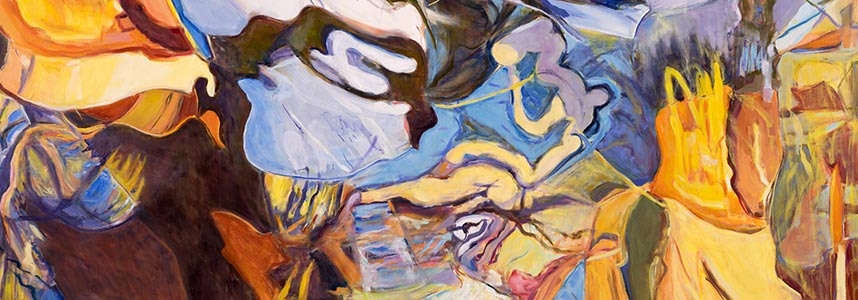
Jil Evans
Tuesday,
November 5, 2019 - December 6, 2019
Alice R. Rogers Gallery & Target Gallery, SJU
The Heart’s Bright and Dark Light
Light, when it occurs in painting, reveals a great deal about what is valued and why. The paintings in the Heart Bright Dark series were made following a year-long study of light in five paintings in the collection of the Minneapolis Institute of Art (Mia). I chose paintings at Mia whose light moved me, in dramatically different ways, to linger in the worlds depicted. I am, like any interested viewer, hungry to meet the mind of the painter revealed in the work, and in this case while spending hours engaged in looking and drawing. My goal with this study was to concentrate on light and the content it can carry, and then bring something new to my own work in abstraction.
I chose paintings that engage light involving a mysterious symbolic relationship with the natural world; light used to depict the passing of glory; light arriving to meet the supernatural and natural; light exposing the difference between danger and contented safety; and the power of light to create tension between habitation and alienation. These are not the only ways light reflects our hearts and minds. My work is intended to inspire further investigation into the profound and nuanced power of light in works of art.
The Studies
The light in the Bassanos’ painting is hallucinatory to me. It portrays several different sources of light, from the mythological light of Neptune and his chariot blazing across the sky, to dawn’s light just breaking in the far distance, to a cool illumination on the fishmongers and the fish almost tipping out of their baskets. Amid this commotion a red-cloaked figure stands under an arch, mysterious in its solitude and stillness.
Poussin’s light reminds me of late summer evening light in the northern hemisphere, when the shadows lengthen and color glows intensely, as if wanting to make a lasting impression of beauty before fading.
In De Hooch’s paintings I am always drawn to the light at the edges of things. In The Asparagus Vendor I go to the window near the woman sewing, where the light collects and hovers along the leaded windowpanes, at the crossing between inside and outside.
I chose Cropsey’s Catskill Mountain Lodge because it has always disturbed me. The light is bright, and the autumnal colors are warm, and yet I experience a terrible coldness. He is serving up the landscape in a bowl of darkness.
Parkes Bonington’s small oil sketch has, to me, light itself as subject. It both builds and destroys material forms. The speed of his eye darting in and around moving rays of sunlight being magnified by the reflecting water is captured by his brushstrokes, his urgency almost two hundred years ago, still alive for us now.

